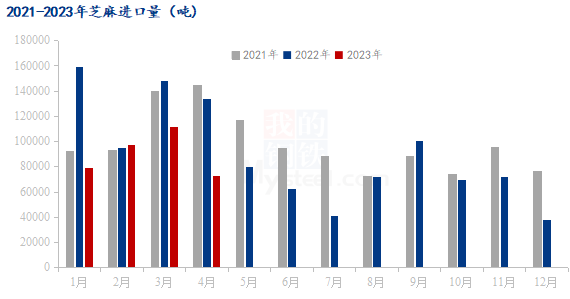1. Overview of sesame imports
According to customs statistics, China's import volume in April 2023 was 73,084.261 tons, a year-on-year decrease of 45.32% and a month-on-month decrease of 34.38%. The import amount was US$117,221,655, a year-on-year decrease of 41% and a month-on-month decrease of 32.90%. The price of imported sesame is high and firm. In the later stage of the market, it is mainly purchased on demand, and stocking is more cautious. For some high-priced sources, traders still maintain the mentality of holding up prices. The previous port inventory can basically meet the demand.
In 2023, the cumulative import of sesame will be 361,061.844 tons, and the cumulative import volume will decrease by 174,445.718 tons or 32.58% compared with the same period last year. The total import value is 563 million US dollars.

2. Main import source countries and import provinces
In April, my country's main import sources of imported sesame were Niger, Togo, Sudan, and Ethiopia. Judging from the import data in April, 34771.098 tons were imported from Niger, accounting for 47.58%; 10986.894 tons were imported from Sudan, accounting for 15.03%; 7603.854 tons were imported from Togo, accounting for 10.4%; 6270 tons were imported from Ethiopia, accounting for 10.4%. 8.58%; 2585.573 tons were imported from Mozambique, accounting for 3.54%; 2426.437 tons were imported from Mali, accounting for 3.32%; 2290.725 tons were imported from Myanmar, accounting for 3.13%; 2233.673 tons were imported from Burkina Faso, accounting for the total imports 3.06% of the amount. 2112.195 tons were imported from Pakistan, accounting for 2.89% of the total imports. The number of imports decreased in April, and the cost of importing sesame seeds was relatively high. In the off-season, oil factories and traders did not purchase much, and more goods were purchased on demand. Downstream enterprises were more cautious in purchasing goods.
Processing demand survey
x